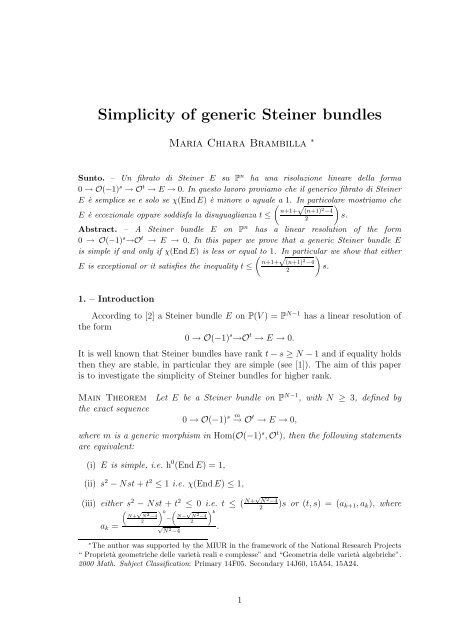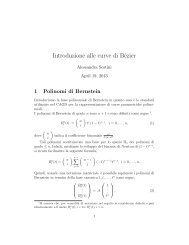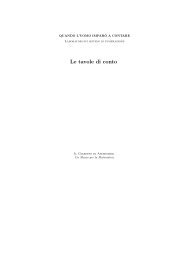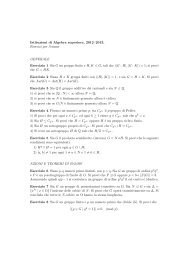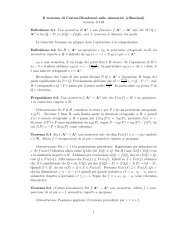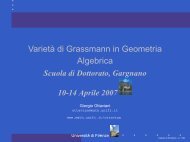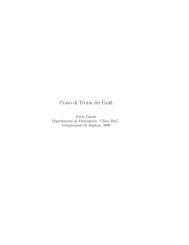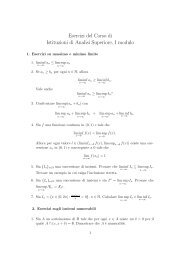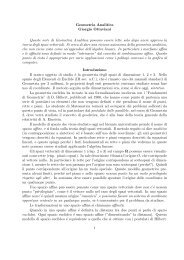Simplicity of generic Steiner bundles - Dipartimento di Matematica e ...
Simplicity of generic Steiner bundles - Dipartimento di Matematica e ...
Simplicity of generic Steiner bundles - Dipartimento di Matematica e ...
You also want an ePaper? Increase the reach of your titles
YUMPU automatically turns print PDFs into web optimized ePapers that Google loves.
<strong>Simplicity</strong> <strong>of</strong> <strong>generic</strong> <strong>Steiner</strong> <strong>bundles</strong>Maria Chiara Brambilla ∗Sunto. – Un fibrato <strong>di</strong> <strong>Steiner</strong> E su P n ha una risoluzione lineare della forma0 → O(−1) s → O t → E → 0. In questo lavoro proviamo che il <strong>generic</strong>o fibrato <strong>di</strong> <strong>Steiner</strong>E è semplice se e solo se χ(EndE) è minore o uguale a 1. In particolare mostriamo che(E è eccezionale oppure sod<strong>di</strong>sfa la <strong>di</strong>suguaglianza t ≤n+1+ √ (n+1) 2 −42Abstract. – A <strong>Steiner</strong> bundle E on P n has a linear resolution <strong>of</strong> the form0 → O(−1) s →O t → E → 0. In this paper we prove that a <strong>generic</strong> <strong>Steiner</strong> bundle Eis simple if and only if χ(EndE) is less or equal(to 1. In particular ) we show that eitherE is exceptional or it satisfies the inequality t ≤s.n+1+ √ (n+1) 2 −42)s.1. – IntroductionAccor<strong>di</strong>ng to [2] a <strong>Steiner</strong> bundle E on P(V ) = P N−1 has a linear resolution <strong>of</strong>the form0 → O(−1) s →O t → E → 0.It is well known that <strong>Steiner</strong> <strong>bundles</strong> have rank t − s ≥ N − 1 and if equality holdsthen they are stable, in particular they are simple (see [1]). The aim <strong>of</strong> this paperis to investigate the simplicity <strong>of</strong> <strong>Steiner</strong> <strong>bundles</strong> for higher rank.Main Theorem Let E be a <strong>Steiner</strong> bundle on P N−1 , with N ≥ 3, defined bythe exact sequence0 → O(−1) s m → O t → E → 0,where m is a <strong>generic</strong> morphism in Hom(O(−1) s , O t ), then the following statementsare equivalent:(i) E is simple, i.e. h 0 (End E) = 1,(ii) s 2 − Nst + t 2 ≤ 1 i.e. χ(End E) ≤ 1,(iii) either s 2 − Nst + t 2 ≤ 0 i.e. t ≤ ( N+√ N 2 −4)s or (t, s) = (a2 k+1 , a k ), wherea k =„N+√N 2 −42« k−„N−√N 2 −4√N 2 −42« k.∗ The author was supported by the MIUR in the framework <strong>of</strong> the National Research Projects“ Proprietà geometriche delle varietà reali e complesse” and “Geometria delle varietà algebriche”.2000 Math. Subject Classification: Primary 14F05. Secondary 14J60, 15A54, 15A24.1
The generalized Fibonacci numbers appearing in (iii) satisfy a recurrence relation,as it is clear from the pro<strong>of</strong> <strong>of</strong> Theorem 2.1.Our result in the case <strong>of</strong> P 2 is partially contained, although somehow hidden, in[3]. Indeed Drézet and Le Potier find a criterion to check the stability <strong>of</strong> a <strong>generic</strong>bundle, given its rank and Chern classes. In the case <strong>of</strong> a normalized <strong>Steiner</strong> bundleE on P 2 , it is possible to prove that if E satisfies con<strong>di</strong>tion (iii) <strong>of</strong> the main theorem,then the Drézet-Le Potier con<strong>di</strong>tion for stability is satisfied. Hence E is stable and,consequently, simple. On the other hand, when E is not normalized, it is verycomplicated to check the criterion <strong>of</strong> Drézet-Le Potier, but we can easily prove thesimplicity with other techniques. Anyway the pro<strong>of</strong> that we present in this paper isindependent <strong>of</strong> [3], is more elementary and works on P n as well.The <strong>generic</strong>ity assumption cannot be dropped, because when rkE = t−s > N −1it is always possible to find a decomposable <strong>Steiner</strong> bundle, that is in particular nonsimple.Since the equivalence between con<strong>di</strong>tions (ii) and (iii) is an arithmetic statement,our theorem claims that χ(End E) is the responsible for the simplicity <strong>of</strong> a <strong>generic</strong><strong>Steiner</strong> bundle E. Indeed it is easy to check that if E is simple then χ(End E) ≤ 1(Lemma 3.2) and this is also true for some other <strong>bundles</strong>, for example for everybundle on P 2 . The converse is not true in general, because it is possible to find anon-simple bundle F on P 2 such that χ(End F) < 1. For example we can considerthe cokernel F <strong>of</strong> a <strong>generic</strong> map <strong>of</strong> the form0 → O(−2) ⊕ O(−1) 4 → O 16 → F → 0,where χ(End F) = −3, but it can be shown that h 0 (End F) = 5 therefore F is notsimple.In the third statement <strong>of</strong> our theorem we claim that if E is a simple <strong>Steiner</strong> bundle,then either E is exceptional or it satisfies a numerical inequality (see Theorem2.1). We recall that exceptional <strong>bundles</strong> have no deformations. The name exceptionalin this setting is justified by the fact that they are the only simple <strong>Steiner</strong><strong>bundles</strong> which violate the numerical inequality. It is remarkable to note that all theexceptional <strong>bundles</strong> on P 2 can be constructed by the theory <strong>of</strong> helices, in particularthere exists a correspondence between the exceptional <strong>bundles</strong> on the projectiveplane and the solutions <strong>of</strong> the Markov equation x 2 + y 2 + z 2 = 3xyz (see [6]).The plan <strong>of</strong> the article is as follows: section 2 is devoted to the case <strong>of</strong> exceptional<strong>bundles</strong> and section 3 to the pro<strong>of</strong> <strong>of</strong> the main theorem. At the end <strong>of</strong> the paper,Theorem 3.8 is a reformulation in terms <strong>of</strong> matrices <strong>of</strong> the main theorem. As a basicreference for <strong>bundles</strong> on P n see [5].I would like to thank Giorgio Ottaviani, for suggesting me the problem and forhis continuous assistance, and Enrique Arrondo, for many useful <strong>di</strong>scussions. I alsothank very much Jean Vallès, for his helpful comments concerning this work, inparticular for his collaboration in simplifying the pro<strong>of</strong> <strong>of</strong> Lemma 3.7.2. – Exceptional <strong>bundles</strong>In [7] the theory <strong>of</strong> helices <strong>of</strong> exceptional <strong>bundles</strong> is developed in a general axiomaticpresentation. Here we give the following result as a particular case <strong>of</strong> this2
theory.Theorem 2.1 [6, 7] Let E k be a <strong>generic</strong> <strong>Steiner</strong> bundle on P N−1 , with N ≥ 3,defined by the exact sequence0 → O(−1) a k−1→O a k→ E k → 0,wherea k =(N+ √ N 2 −42) k−(√N2 − 4N− √ ) kN 2 −42,then E k is exceptional (i.e. h 0 (End E) = 1 and h i (End E) = 0 for all i > 0.)On P(V ) = P N−1 we define a sequence <strong>of</strong> vector <strong>bundles</strong> as follows:F 0 = O(1), F 1 = O, F n+1 = ker(F n ⊗ Hom(F n , F n−1 ) → ψnF n−1 ), (1)where ψ n is the canonical map.The following lemma can be found in [7]. We underline that it is possible toprove it in a straightforward way only by standard cohomology sequences.Lemma 2.2 Given the definition (1), for all n ≥ 1 the canonical map ψ n is anepimorphism. Moreover the following properties (A n ), (B n ) and (C n ) are satisfiedfor all n ≥ 1:(A n ) Hom(F n , F n ) ∼ = C, Ext i (F n , F n ) = 0, for all i ≥ 1,(B n ) Hom(F n−1 , F n ) = 0, Ext i (F n−1 , F n ) = 0, for all i ≥ 1,(C n ) Hom(F n , F n−1 ) ∼ = V, Ext i (F n , F n−1 ) = 0, for all i ≥ 1.Note that (A n ) means that every F n is an exceptional bundle.Remark 2.3 Following [7] the previous lemma means that (F n , F n−1 ) is a left admissiblepair and (F n+1 , F n ) is the left mutation <strong>of</strong> (F n , F n−1 ) and that the sequence(F n ) forms an exceptional collection generated by the helix (O(i)) by left mutations.Pro<strong>of</strong> <strong>of</strong> Theorem 2.1. Lemma 2.2 states that the <strong>bundles</strong> F n , defined as in(1), are exceptional for all n ≥ 0. Obviously their dual Fn ∗ are exceptional too. Nowwe will prove that, for every n ≥ 1, the bundle Fn ∗ admits the following resolution0 → O(−1) a n−1→O an → F ∗ n→ 0, (2)where {a n } is the sequence defined in the statement. This implies that a <strong>generic</strong>bundle with this resolution is exceptional. We can prove (2) by induction on n.First <strong>of</strong> all we notice that the sequence {a n } is also defined recursively by⎧⎨⎩a 0 = 0,a 1 = 1,a n+1 = Na n − a n−1 .3
Therefore if n = 1 the sequence (2) is 0 → O(−1) a 0→O a 1→ F1 ∗ → 0, i.e.0→O→F1 ∗ → 0, and this is true because F 1∼ = O. Now let us suppose that everyFk ∗ admits a resolution (2) for all k ≤ n and we will prove it for F n+1 ∗ . Let usdualize the sequence0 → F n+1 → F n ⊗ Hom(F n , F n−1 ) → F n−1 → 0and by induction hypothesis we have:0 00 F ∗ n−1F ∗ n ⊗ V ∗F ∗ n+1 0O a n−1O an ⊗ V ∗O(−1) a n−2O(−1) a n−1⊗ V ∗00We define the map α : O a n−1→ F ∗ n ⊗ V ∗ as the composition <strong>of</strong> the known maps.Since Ext 1 (O a n−1, O(−1) a n−1⊗ V ∗ ) ∼ = H 1 (O(−1)) a2 n−1 ⊗ V ∗ = 0, the map α inducesa map ˜α : O a n−1→ O an ⊗ V ∗ such that the following <strong>di</strong>agram commutes:0 00 F ∗ n−1O a n−1f Fn ∗ ⊗ V ∗α eα O an ⊗ V ∗F ∗ n+1 0O(−1) a n−2O(−1) a n−1⊗ V ∗00We observe that ˜α is injective if and only if H 0 (˜α) is injective and, since H 0 (˜α) =H 0 (f), they are injective. Obviously the cokernel <strong>of</strong> ˜α is O Nan−a n−1= O a n+1. Let˜β be the restriction <strong>of</strong> ˜α to O(−1) a n−2. Then we can check that ˜β is injective, its4
cokernel is O(−1) Na n−1−a n−2= O(−1) an and the following <strong>di</strong>agram commutes:0 0 00 Fn−1∗ Fn ∗ ⊗ V ∗α0 O a eαn−1 O an ⊗ V ∗F ∗ n+1O a n+1000 O(−1) a n−2 eβ O(−1) a n−1⊗ V ∗ O(−1) an 0000It follows that Fn+1 ∗ has the resolution 0 → →O a O(−1)an n+1→ Fn+1 ∗completes the pro<strong>of</strong> <strong>of</strong> our theorem.→ 0 and this3. – Pro<strong>of</strong> <strong>of</strong> the main theoremLet E be given by the exact sequence on P N−1 = P(V )0 −→ I ⊗ O(−1)m−→ W ⊗ O −→ E −→ 0, (3)where V , I and W are complex vector spaces <strong>of</strong> <strong>di</strong>mension N ≥ 3, s and t respectivelyand m is a <strong>generic</strong> morphism. If we fix a basis in each <strong>of</strong> the vector spaces Iand W, the morphism m can be represented by a t × s matrix M whose entries arelinear forms. Let us consider the natural action <strong>of</strong> GL(I) × GL(W) on the spacei.e. the actionH = Hom(I ⊗ O(−1), W ⊗ O) ∼ = V ⊗ I ∨ ⊗ W,H × GL(I) × GL(W) → H(M, A, B) ↦→ A −1 MB.When the pair (A, B) belongs to the stabilizer <strong>of</strong> M, it induces a morphism φ : E →E, such that the following <strong>di</strong>agram commutes:0 I ⊗ O(−1) M W ⊗ OE0(4)A0 I ⊗ O(−1) M W ⊗ O E 0BφI. Now we prove the first part <strong>of</strong> the theorem, i.e. the fact that (i) implies (ii).5
Remark 3.1 From the sequence (3) it follows that χ(E) = t and χ(E(1)) = (Nt −s). Dualizing (3) and tensoring by E we gettherefore0 −→ End E −→ W ∨ ⊗ E−→I ∨ ⊗ E(1) −→ 0, (5)χ(End E) = tχ(E) − sχ(E(1)) = t 2 − s(Nt − s) = t 2 − Nst + s 2 .Lemma 3.2 If E is a simple <strong>Steiner</strong> bundle, then χ(End E) ≤ 1.Pro<strong>of</strong>. From the sequences (3) and (5) it is easy to check that H i (End E) = 0,for all i ≥ 2. Moreover h 0 (End E) = 1 because <strong>of</strong> the simplicity, and consequentlyχ(End E) = 1 − h 1 (End E) ≤ 1.II. Now we prove that statement (ii) is equivalent to (iii).Remark 3.3 Obviously s 2 − Nst + t 2 ≤ 0 is equivalent to ( N−√ N 2 −42)s ≤ t ≤( N+√ N 2 −4)s. Since t > s and N > 2 this inequality is equivalent to t ≤ ( N+√ N 2 −4)s.2 2Thus we have only to prove that s 2 −Nst+t 2 = 1 is equivalent to (t, s) = (a k+1 , a k )where a k has been defined above.Lemma 3.4 All the integer solutions <strong>of</strong> s 2 − Nst + t 2 = 1, when t > s, are exactlys = a k , t = a k+1 , where a k =„N+√N 2 −42« k−„N−√N 2 −4√N 2 −42« k.Pro<strong>of</strong>. We already know that the sequence {a k } is defined recursively by⎧⎨ a 0 = 0,a 1 = 1,⎩a k+1 = Na k − a k−1 .So we prove by induction on k that (s = a k , t = a k+1 ) is a solution <strong>of</strong>s 2 − Nst + t 2 = 1. (6)If k = 0, obviously (s = 0, t = 1) is a solution. Let the pair (a k−1 , a k ) satisfy (6),then, using the recursive definition, we check that (a k , a k+1 ) is a solution too. Hencewe have to prove that there are no other solution. By the change <strong>of</strong> coor<strong>di</strong>nates{r = 2t − Ns, s = s} our equation becomes the following Pell-Fermat equationr 2 − (N 2 − 4)s 2 = 4. By Number Theory results (see for example [8], page 77, or[4]), we know that all the solutions (r, s) are given by the sequence (r k , s k ) definedbyr k + s k√N2 − 4 = 12 k−1(N + √ N 2 − 4) k ,6
for all k ≥ 0. Now we have only to prove that these solutions are exactly thosealready known. We can easily check that the pair <strong>of</strong> sequences (s k , t k ) can berecursively defined by⎧⎪⎨⎪⎩r 0 = 2,s 0 = 0,r k+1 = (N2 −4)s k +Nr ks k+1 = Ns k+r k,2.2By a change <strong>of</strong> coor<strong>di</strong>nates we define t k = Ns k+r kand we check that the pair (s2 k , t k )is exactly (a k , a k+1 ), for all k ≥ 0. In fact (s 0 , t 0 ) = (0, 1) = (a 0 , a 1 ) and, moreover,t k = s k+1 and t k+1 = Ns k+1+r k+1= (N2 −2)s k +Nr k= (N2 −2)s k +N(2t k −Ns k )= Nt2 2 2 k − t k−1 .III. Now we prove the last implication, i.e. (iii) implies (i). In the case (t, s) =(a k+1 , a k ), the <strong>generic</strong> E is an exceptional bundle by Theorem 2.1, therefore it isin particular simple. So suppose s 2 − Nst + t 2 ≤ 0 and recall that H denotesHom(I ⊗ O(−1), W ⊗ O) ∼ = V ⊗ I ∨ ⊗ W. Let S be the set{A, B, M : A −1 MB = M} ⊂ GL(I) × GL(W) × Hand π 1 and π 2 the projections on GL(I) × GL(W) and on H respectively. Noticethat, for all M ∈ H, π 1 (π2 −1 (M)) is the stabilizer <strong>of</strong> M with respect to the action <strong>of</strong>GL(I) × GL(W). Obviously (λ Id, λ Id) ∈ Stab(M), therefore <strong>di</strong>m Stab(M) ≥ 1.Lemma 3.5 If E is defined by the sequenceand <strong>di</strong>m Stab(M) = 1, then E is simple.0 −→ I ⊗ O(−1) M−→ W ⊗ O −→ E −→ 0 (7)Pro<strong>of</strong>. If by contra<strong>di</strong>ction E is not simple, then there exists φ : E → E nontrivial.Applying the functor Hom(−, E) to the sequence (7) we get that φ induces˜φ non-trivial in Hom(W ⊗ O, E). Now applying the functor Hom(W ⊗ O, −) againto the same sequence we get Hom(W ⊗ O, W ⊗ O) ∼ = Hom(W ⊗ O, E) becauseHom(W ⊗O, I ⊗O(−1)) ∼ = W ⊗I ⊗H 0 (O(−1)) = 0 and Ext 1 (W ⊗O, I ⊗O(−1)) ∼ =W ⊗ I ⊗ H 1 (O(−1)) = 0. It follows that there exists ˜φ non-trivial in End(W ⊗ O),i.e. a matrix B ≠ Id in GL(W). Restricting ˜φ to I ⊗ O(−1) and calling A thecorrespon<strong>di</strong>ng matrix in GL(I), we get the commutative <strong>di</strong>agram (4). Therefore(A, B) ≠ (λ Id, λ Id) belongs to Stab(M) and consequently <strong>di</strong>m Stab(M) > 1.Finally it suffices to prove that for all <strong>generic</strong> M ∈ H, the <strong>di</strong>mension <strong>of</strong> thestabilizer is exactly 1. In other words we have to prove the followingProposition 3.6 Let H = V ⊗ I ∨ ⊗ W as above and suppose s 2 − Nst + t 2 ≤ 0.Then the <strong>generic</strong> orbit in H with respect to the natural action <strong>of</strong> GL(I) × GL(W)has <strong>di</strong>mension exactly (s 2 + t 2 − 1).7
Recall that we have defined the following <strong>di</strong>agramS = {A, B, M : A −1 MB = M} π1π 2GL(I) × GL(W)HLet (A, B) be two fixed Jordan canonical forms in GL(I) × GL(W). We defineG AB ⊂ GL(I)×GL(W) as the set <strong>of</strong> couples <strong>of</strong> matrices similar respectively to A andB. Note that π 2 π1 −1 (G AB) = {C −1 MD : A −1 MB = M, C ∈ GL(I), D ∈ GL(W)}.Moreover G Id Id = {(λ Id, λ Id), λ ∈ C} and π 2 π1 −1 (G Id Id ) = H.Lemma 3.7 If s 2 − Nst + t 2 ≤ 0 and (A, B) are Jordan canonical forms <strong>di</strong>fferentfrom (λ Id, λ Id) for any λ, then π 2 π1 −1 (G AB) is contained in a Zariski closed subsetstrictly contained in H.Pro<strong>of</strong>. Suppose that the assertion is false. Then there exist two Jordan canonicalforms A and B, <strong>di</strong>fferent from (λ Id, λ Id), such that π 2 π1 −1 (G AB) is not containe<strong>di</strong>n any closed subset. This implies that we can take a general M ∈ H such thatAM = MB and in particular we can suppose the rank <strong>of</strong> M maximum.Now we prove that A and B have the same minimal polynomial. First, if p B is theminimal polynomial <strong>of</strong> B, i.e. p B (B) = 0, then it follows that p B (A)M = Mp B (B) =0 and since M is injective we get p B (A) = 0, hence the minimal polynomial <strong>of</strong>B <strong>di</strong>vides that <strong>of</strong> A. Now if we denote by λ i (1 ≤ i ≤ q) the eigenvalues <strong>of</strong>A and by µ j (1 ≤ j ≤ q ′ ) those <strong>of</strong> B, we obtain that µ j ∈ {λ 1 , . . .,λ q } for all1 ≤ j ≤ q ′ . Let us define A ′ = (A − x Id s ) and B ′ = (B − x Id t ): obviously weobtain A ′ M = MB ′ . We denote by B ′ the matrix <strong>of</strong> c<strong>of</strong>actors <strong>of</strong> B ′ and we knowthat B ′ B ′ = det(B ′ ) Id t = P B (x) Id t , where P B is the characteristic polynomial <strong>of</strong>B. ThereforeA ′ MB ′ = P B (x)Mand developing this expression we see that q ′ = q. In fact if there exists a λ i ≠ µ jfor all j = 1, . . ., q ′ , then there is a row <strong>of</strong> zeroes in M and consequently M isnot <strong>generic</strong>. Then we get A and B with the same eigenvalues λ i (1 ≤ i ≤ q) withmultiplicity respectively a i ≥ 1 and b i ≥ 1. The hypothesis that (A, B) ≠ (λ Id, λ Id)means that either A and B have more than one eigenvalue or at least one <strong>of</strong> themis non-<strong>di</strong>agonal.∑Now consider the first case, i.e. q ≥ 2. Since <strong>di</strong>m I = s and <strong>di</strong>m W = t, obviouslyqi=1 a i = s e ∑ qi=1 b i = t. Now we denote M = (M ij ), where M ij has <strong>di</strong>mensiona i × b j . Since AM = MB, every block M ij is zero for all i ≠ j, i.e. it is possible towrite M with the form ⎛ ⎞∗ 0 · · · 00 ∗ · · · 0M = ⎜⎝.0 0 ..⎟ 0 ⎠ .0 0 · · · ∗8
In particular we can define n 1 = a 1 , n 2 = ∑ pi=2 a i, m 1 = b 1 , m 2 = ∑ pi=2 b i and thusthe matrix M becomes( )(∗)n1 ×mM = 1(0) n1 ×m 2(8)(0) n2 ×m 1(∗) n2 ×m 2where n 1 +n 2 = s and m 1 +m 2 = t and n i , m i ≥ 1 for i = 1, 2. Thus it only sufficesto show that a matrix in the orbitO M = {C −1 MD : C ∈ GL(s), D ∈ GL(t), M with the form (8)},is not <strong>generic</strong> in H if s 2 − Nst + t 2 ≤ 0. This fact contra<strong>di</strong>cts our assumption andcompletes the pro<strong>of</strong>.In order to show this, we introduce the following <strong>di</strong>agrams{φ, I 1 , W 1 : φ(I 1 ⊗ V ∨ ) ⊆ W 1 }α1 β 1H = Hom(I ⊗ V ∨ , W) G 1 = G(C n 1, C s ) × G(C m 1, C t ))where G(C k , C h ) denotes the Grassmannian <strong>of</strong> C k ⊂ C h and{φ, I 2 , W 2 : φ(I 2 ⊗ V ∨ ) ⊆ W 2 }α2 β 2H = Hom(I ⊗ V ∨ , W) G 2 = G(C n 2, C s ) × G(C m 2, C t ))It is easy to check that the matrices <strong>of</strong> the set O M live in the subvariety˜H = α 1 (β −11 (G 1)) ∩ α 2 (β −12 (G 2)) ⊆ H,then, in order to prove that these matrices are not <strong>generic</strong>, it suffices to show that<strong>di</strong>m ˜H < <strong>di</strong>m H. Since <strong>di</strong>m(G i ) = (n 1 n 2 + m 1 m 2 ) for i = 1, 2, we obtainand<strong>di</strong>m(α 1 (β −11 (G 1))) ≤ <strong>di</strong>m(β −11 (G 1)) = n 1 n 2 + m 1 m 2 + N(n 1 (m 1 + m 2 ) + n 2 m 2 )<strong>di</strong>m(α 2 (β −12 (G 2 ))) ≤ <strong>di</strong>m(β −12 (G 2 )) = n 1 n 2 + m 1 m 2 + N(n 1 m 1 + n 2 (m 1 + m 2 )).Therefore, since <strong>di</strong>m H = Nst = N(n 1 + n 2 )(m 1 + m 2 ) we only need to show thateither (n 1 n 2 +m 1 m 2 −Nn 2 m 1 ) < 0 or (n 1 n 2 +m 1 m 2 −Nn 1 m 2 ) < 0. In other wordswe have to prove that the system{n1 n 2 + m 1 m 2 − Nn 1 m 2 ≥ 0n 1 n 2 + m 1 m 2 − Nn 2 m 1 ≥ 0has no solutions in our hypotesis s 2 − Nst + t 2 ≤ 0, i.e. ifN − √ N 2 − 42t ≤ s ≤ N + √ N 2 − 4t.29
This is equivalent to prove that the system⎧n 1 n 2 + m 1 m 2 − Nn 1 m 2 ≥ 0⎪⎨ n 1 n 2 + m 1 m 2 − Nn 2 m 1 ≥ 0n 1 + n 2 ≥ ⎪⎩N−√ N 2 −4(m 2 1 + m 2 )n 1 + n 2 ≤ N+√ N 2 −4(m 2 1 + m 2 )has no solutions. In order to do it, consider n 1 and m 1 as parameters and write theprevious system as a system <strong>of</strong> linear inequalities in two unknowns n 2 and m 2 :⎧⎪⎨⎪⎩n 1 n 2 ≥ (Nn 1 − m 1 )m 2(n 1 − Nm 1 )n 2 ≥ −m 1 m 2n 2 ≥ α − m 2 + (α − m 1 − n 1 )n 2 ≤ α + m 2 + (α + m 1 − n 1 )where we denote α − = N−√ N 2 −4and α2 + = N+√ N 2 −4. Notice that (α2 − + α + ) = Nand α − α + = 1, because they are solutions <strong>of</strong> the equation s 2 − Nst + t 2 = 0. Nowlet us consider three cases:• if 0 < n 1 − α + m 1 the system{n2 ≥ (Nn 1−m 1 )n 1m 2n 2 ≤ α + m 2 + (α + m 1 − n 1 )has no solutions because (α + m 1 − n 1 ) < 0 and α + < (Nn 1−m 1 )n 1, since (N −α + )n 1 − m 1 = α − n 1 − m 1 = (α + ) −1 (n 1 − α + m 1 ) > 0;• if n 1 − α + m 1 < 0 < n 1 − α − m 1 the system is{n 2 ≥ (Nn 1−m 1 )n 2 ≤n 1m 2m 1m (Nm 1 −n 1 ) 2because Nm 1 − n 1 > α + m 1 − n 1 > 0 and there is no solution becausem 1< (Nn 1−m 1 )(Nm 1 −n 1 ) n 1, since N(Nn 1 m 1 − m 2 1 − n 2 1) > 0;• if n 1 − α − m 1 < 0 then the system{m n2 ≤ 1m (Nm 1 −n 1 ) 2n 2 ≥ α − m 2 + (α − m 1 − n 1 )has no solutions because (α − m 1 − n 1 ) > 0 and α − >(Nm 1 −n 1 )m 1, since (N − α + )m 1 − n 1 = α − m 1 − n 1 > 0.Thus the pro<strong>of</strong> in the case q ≥ 2 is complete.In the second case we consider q = 1 and the two matrices are⎛⎞⎛ ⎞λ 1J 1⎜A = ⎝. ..⎟λ 1⎠ , where J i = ⎜⎝.. ...⎟ . ⎠J hλ10m 1(Nm 1 −n 1 )i.e. α +
and c i denotes the order <strong>of</strong> J i andB =⎛⎜⎝L 1. ..L k⎞⎟⎠ , where L i =⎛⎜⎝λ 1λ 1. .. . ..λ⎞⎟⎠and d i is the order <strong>of</strong> L i . We suppose that c 1 ≥ 2 or d 1 ≥ 2 i.e. h < s or k < t. Thena matrix M such that AM = MB has the form M = (M ij ) and M ij is a c i × d jmatrix such that ⎧⎨ T c if c i = d j = cM ij = (0|T c ) if c = c i < d j⎩( T d0) if c i > d j = dand T c is a c × c upper-triangular Toeplitz matrix. It is easy to see that M has atleast k columns in which there are at least (c 1 −1)+(c 2 −1)+. . .+(c h −1) = (s−h)zeroes in such a way that we can order the basis so as to write M in the followingform ( )(∗)h×k (∗) h×(t−k).(0) (s−h)×k (∗) (s−h)×(t−k)Analogously M has at least h rows with at least (t−k) zeroes such that it is possibleto write the matrix in the form( )(∗)h×k (0) h×(t−k).(∗) (s−h)×k (∗) (s−h)×(t−k)Hence there exist non-trivial subspaces I 1 , I 2 , W 1 , W 2 such that M(I i ⊗ V ∨ ) ⊆ W i ,for i = 1, 2, and <strong>di</strong>m I 1 = s − h, <strong>di</strong>m W 1 = k, <strong>di</strong>m I 2 = h, <strong>di</strong>m W 2 = t − k. Thereforeexactly the same argument used in the first case gives that M is not <strong>generic</strong> andcompletes the pro<strong>of</strong>.The previous lemma proves Proposition 3.6 and the main theorem follows. Thistheorem can also be reformulated as follows:Theorem 3.8 Let M a (s×t) matrix whose entries are linear forms in N variablesand consider the systemXM = MY, (9)where X ∈ GL(s) and Y ∈ GL(t) are the unknowns. Then if s 2 +t 2 −Nst ≤ 1, thereis a dense subset <strong>of</strong> the vector space C s ⊗C t ⊗C N , where M lives, such that the onlysolutions <strong>of</strong> (9) are trivial, i.e. (X, Y ) = (λ Id, λ Id) ∈ GL(s) × GL(t) for λ ∈ C.Conversely if s 2 + t 2 − Nst ≥ 2, then for all M there are non-trivial solutions.11
REFERENCES[1] V. Ancona and G. Ottaviani. Stability <strong>of</strong> special instanton <strong>bundles</strong> on P 2n+1 .Trans. Amer. Math. Soc., 341(2): 677–693, 1994.[2] I. Dolgachev and M. Kapranov. Arrangements <strong>of</strong> hyperplanes and vector <strong>bundles</strong>on P n . Duke Math. J., 71(3): 633–664, 1993.[3] J.-M. Drézet and J. Le Potier. Fibrés stables et fibrés exceptionnels sur P 2 . Ann.Sci. École Norm. Sup. (4), 18(2): 193–243, 1985.[4] H. W. Lenstra, Jr. Solving the Pell equation. Notices Amer. Math. Soc., 49(2):182–192, 2002.[5] C. Okonek, M. Schneider, and H. Spindler. Vector <strong>bundles</strong> on complex projectivespaces, volume 3 <strong>of</strong> Progress in Mathematics. Birkhäuser Boston, Mass., 1980.[6] A. N. Rudakov. Markov numbers and exceptional <strong>bundles</strong> on P 2 . Izv. Akad.Nauk SSSR Ser. Mat., 52(1): 100–112, 240, 1988.[7] A. N. Rudakov. Helices and vector <strong>bundles</strong>, volume 148 <strong>of</strong> London MathematicalSociety Lecture Note Series. Cambridge University Press, Cambridge, 1990.[8] P. Samuel. Théorie algébrique des nombres. Hermann, Paris, 1967.<strong>Dipartimento</strong> <strong>di</strong> <strong>Matematica</strong> “U.Dini”Viale Morgagni 67/A50134 Firenze, Italyemail: brambilla@math.unifi.it12


